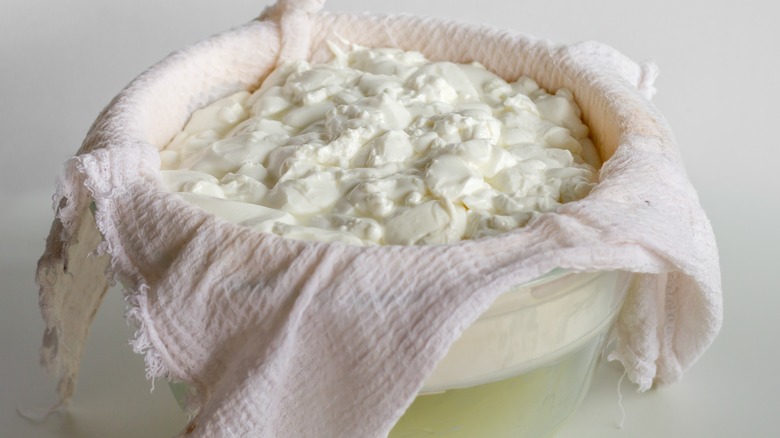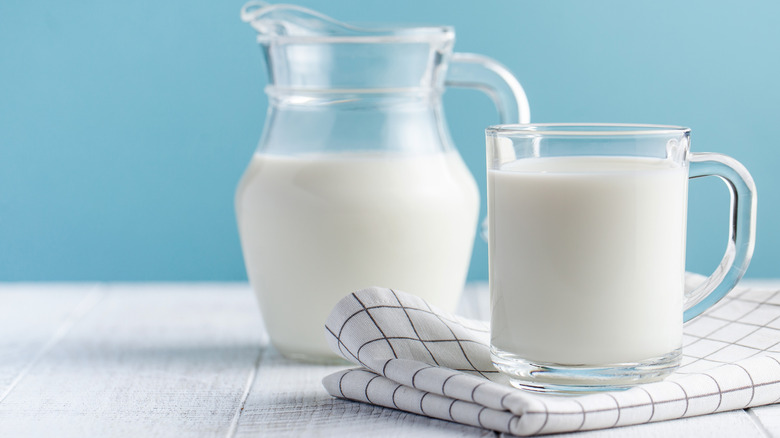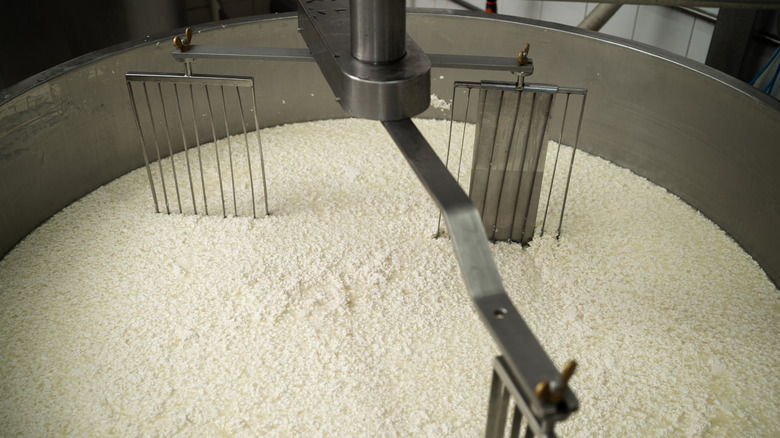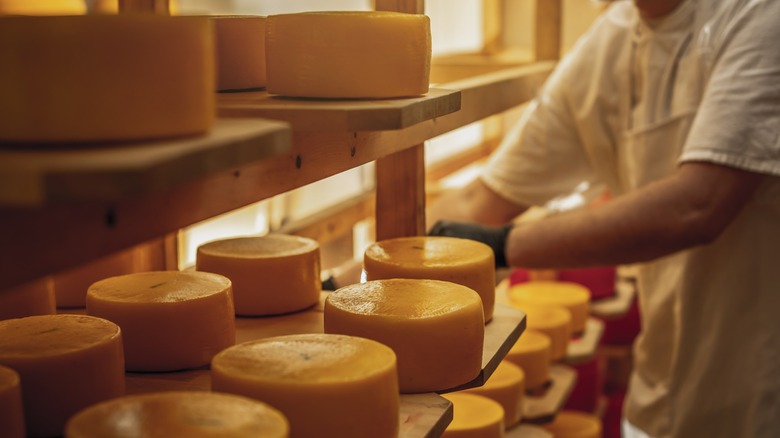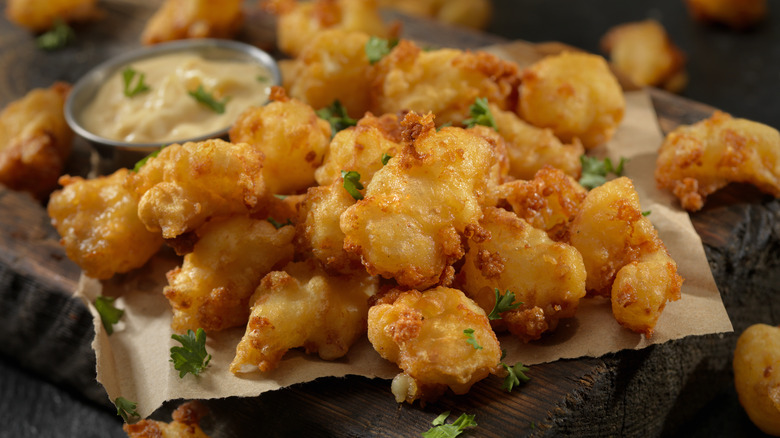There's More To Curds And Whey Than A Catchy Nursery Rhyme
Don't let Miss Muffet's frightful encounter fool you. Curds and whey are far from the dairy drama of yesteryear.
Beyond the catchy nursery rhyme, curds and whey reveal a world rooted in the art of cheese-making. They are, in fact, two distinct components that result from the process of separating milk solids from the liquid while making cheese. This separation can occur naturally or be brought on by other ingredients.
The primary difference between curds and whey lies in their composition and texture that occurs from the separation. The curd signifies the first component, the solid. The curd can become the initial step in your cheesemaking journey or be used as is. On the other hand, whey represents the liquid part left over from the curd forming.
This leaves us to conclude that Miss Muffet was likely consuming the remnants of the early stages of modern-day cheesemaking — or, in simple terms, raw cottage cheese. However, despite the nostalgia of that nursery rhyme published in 1805, today's curds and whey have had their glow-up, and cottage cheese is now required to go through the process of washing, salting, and draining before being available to consumers like Miss Muffet.
Ingredients of curds and whey
The composition of curds and whey revolves around a single ingredient: milk. This gives rise to two distinct components — curds and whey. However, what are these two separate entities made up of? To start, curds consist primarily of casein proteins. These proteins cluster to create a solid structure, resulting in a soft, crumbly texture. Casein constitutes 80% of the makeup of milk protein, while whey accounts for the remaining 20% according to Healthline. As for the makeup of whey, it retains residual water, lactose, minerals, and soluble proteins.
Some producers incorporate additional components into the mix, such as rennet, to aid milk coagulation. Rennet can be sourced from the stomach lining of young calves, goats, and lambs, given their diet primarily comprises milk. However, this ingredient can also be rendered vegetarian by using alternative plants to create enzymes, such as nettles or thistles.
Now, in terms of what they taste like, the curds offer a pleasantly creamy sensation on the palate, imparting a mild and subtle dairy flavor. Think of the water you see at the top of the yogurt — that is whey. It flows freely, much like milk, yet possesses a slightly viscous quality. Whey delivers a tangy and slightly sour note, reminiscent of yogurt or cultured dairy products. These differences in texture and taste contribute to their unique applications and their significance in the cheese-making process.
How modern-day curds and whey are made
Hold on to your cheese knives, folks, because we're diving into the high-tech symphony of modern curds and whey production. To begin, milk is typically pasteurized to eliminate harmful bacteria while preserving the desired enzymes. Once pasteurized, acidification is induced by adding a culture to turn the mixture into lactic acid. Coagulation then starts when rennet or acid enters the mix, which prompts the separation of curds and whey.
As the separation finishes, the curds are ready to be cut. However, before the curds are cut, it is important to look out for a clean break; slicing too early could lead to an overly wet and tangy cheese situation. Additionally, the smaller the pieces of curd are cut, the harder the cheese. For example, Gruyère would be cut into way smaller pieces than soft Brie cheese.
After cutting, the whey is then drained, leaving behind only the curds. Depending on the desired texture and flavor, curds can be pressed to expel additional whey or left to drain naturally. Now in the case of cheesemaking, the curds are then further processed by adding cream, salt, or other ingredients. Curds and whey showcase milk's diverse, more "spoily" elements, offering cheesemakers the canvas to create a wide variety of different cheeses.
The transformation of curds and whey
Both curds and whey have vast culinary applications and can be incorporated into a variety of dishes. These variations stem from differences in milk sources, processing techniques, aging periods, and regional traditions. Cheddar cheese curds, perhaps the most well-known variation, boast a mild, slightly tangy taste with a springy texture and are perfectly tasty as is or even fried. Additionally, an untouched fresh cheese curd is considered an early cheddar. And a true cheese curd will squeak, due to the enamel of your teeth rubbing against the calcium and protein of the curd.
In contrast, fresh mozzarella cheese curds deliver a creamy consistency with a delicate milkiness due to less cutting of the cheese. And let's not forget about paneer, a staple in Indian cooking. Paneer offers a crumbly, yet cohesive, texture, making it ideal for absorbing rich flavors in curries and stir-fries. But that's not where the curd transformation ends. Curds can also undergo more extreme changes during the cheesemaking process with the addition of Penicillium roqueforti, leading to diverse outcomes such as blue cheese curds with their characteristic veins of mold.
As for whey, its role extends beyond the cheese-making realm as it contributes to sustainable practices. Whey is often used as a nutritious supplement in animal feed, providing essential nutrients to livestock. Furthermore, its probiotic content makes it an ideal starter culture for fermenting vegetables and other foods, enhancing their flavor and preservation.
History of curds and whey
Step into the culinary time machine, folks, because we're traveling back to the early days of curds and whey. While the exact origins remain obscured by time, the evolution of curds and whey can be traced back thousands of years. Early civilizations, likely in the Middle East and Europe, stumbled upon the curious transition from milk to curds and whey through the natural processes of milk spoilage. Historical records suggest that cheese-making practices were prevalent in ancient Egypt, Greece, and Rome. These civilizations refined and codified techniques, contributing to the diversity of cheeses we enjoy today. The process was not only a means of preserving surplus milk but also a way to enhance its nutritional value and flavor.
Over time, cheese-making knowledge spread through trade routes and cultural exchanges, leading to the development of distinct cheese varieties in different regions. Factors like colder weather led to less salt being added to the mix, resulting in softer, milder cheeses. Mass production of cheeses, however, didn't start until 1815 in Switzerland, when the first cheese factory was built according to Cheeses from Switzerland. While no single individual or culture can be definitively credited with the invention of cheese-making, the transformation of curds and whey evolved organically as an essential culinary practice, shaped by the ingenuity and resourcefulness of diverse civilizations across history.
Where can you buy curds and whey
Hold onto your culinary curiosity, because after delving into the fascinating duo's history, you might be itching to discover where to find them. Well, curds and whey can be sourced from various outlets. Local cheese shops and artisanal food markets often feature fresh cheese curds. Dairy farms, particularly those with on-site processing, might offer curds and whey for sale, especially if cheese production is part of their repertoire. And some local groceries do carry cheese curds, just be sure they are actual curds and not just cheese chunks in disguise.
Moreover, curds and whey have found their way onto restaurant menus. Poutine, a beloved Canadian comfort dish, often showcases these elements as a savory topping. You can also find fried cheese curds on menus and sometimes sold at fairs. And if you're wondering whether you can make curds and whey— or even cheese — at home, technically speaking, you can. Just grab some milk, a splash of vinegar, and a bit of patience. So, go ahead and follow Miss Muffet's lead and give the curds and whey a try. Then, check out what you didn't know about ricotta cheese next!
